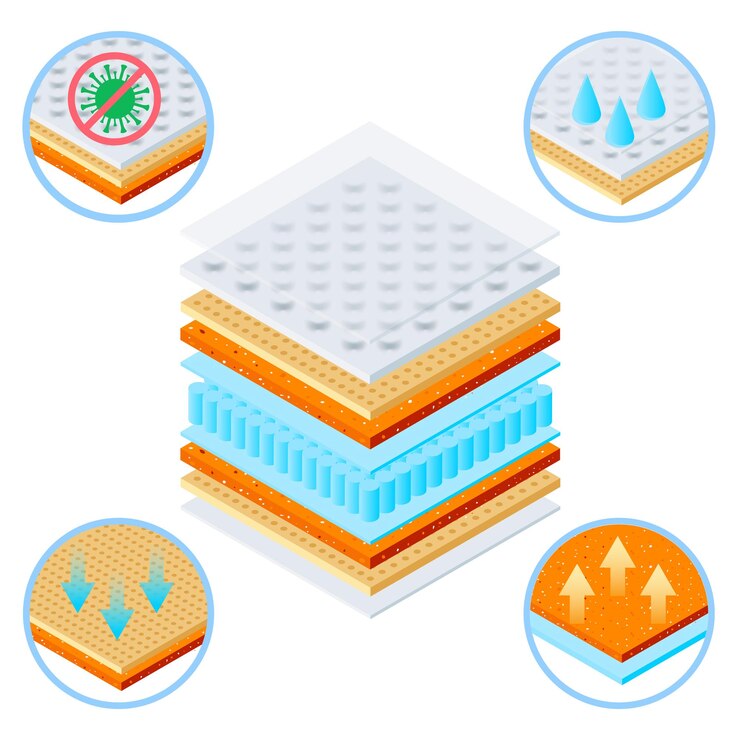Xiaomi Power Bank 4i 20000mAh 33W Super Fast Charging PD | Power Delivery | QC 3.0|Type C Input & Output |Triple Output Ports|Blue|Supports Android,Apple, Tablets, Earbuds, Watches etc (MI)
₹1,999.00 (as of December 20, 2024 20:32 GMT +05:30 - More infoProduct prices and availability are accurate as of the date/time indicated and are subject to change. Any price and availability information displayed on [relevant Amazon Site(s), as applicable] at the time of purchase will apply to the purchase of this product.)Single-layer membrane technology has revolutionized various industries, particularly in areas like water treatment, gas separation, and energy storage. Its importance stems from its efficiency, cost-effectiveness, and the ability to offer superior performance compared to traditional methods. In this article, we will delve into the science behind single-layer membranes, their working principles, benefits, and applications across different sectors.
What is Single Layer Membrane Technology?
Single-layer membranes are thin films made up of specific materials that allow selective permeability, enabling them to filter substances at the molecular level. These membranes typically consist of a single layer of material, designed to control the passage of certain particles, ions, or molecules while blocking others. The selective nature of these membranes makes them crucial in processes like desalination, wastewater treatment, and even in advanced fields like fuel cell technology.
The Science Behind Single Layer Membranes
The science of single-layer membrane technology revolves around the concept of molecular sieving and selective permeation. The membrane's material and pore size determine its ability to allow certain molecules to pass through while restricting others. This selective permeability depends on factors such as:
Pore Size and Distribution: The size of the pores in a single-layer membrane plays a critical role in its filtering capabilities. Smaller pores are more effective at filtering out unwanted particles, while larger pores allow for higher flow rates but may permit the passage of unwanted substances.
Material Properties: The membrane material significantly affects its selectivity and durability. Common materials used in single-layer membranes include polymers, ceramics, graphene oxide, and even metal-organic frameworks (MOFs). Each material offers unique properties that make the membrane suitable for different applications. For instance, graphene oxide membranes have gained popularity due to their superior mechanical strength, high permeability, and chemical stability.
Transport Mechanisms: Single-layer membranes operate based on different transport mechanisms, such as diffusion, sieving, and charge repulsion. In gas separation, for example, gas molecules diffuse through the membrane at different rates based on their size and interaction with the membrane material. In liquid separation, such as water desalination, the membrane acts as a sieve, allowing water molecules to pass while blocking salts and other impurities.
Types of Single Layer Membranes
Microfiltration Membranes: These membranes have larger pore sizes, typically between 0.1 to 10 micrometers, and are suitable for filtering large particles such as bacteria and suspended solids. Microfiltration is often used in the food and beverage industry, pharmaceutical processing, and wastewater treatment.
Ultrafiltration Membranes: Ultrafiltration membranes have smaller pores (0.01 to 0.1 micrometers) and are effective in removing proteins, viruses, and colloidal substances. This technology is commonly employed in water purification, dairy processing, and blood plasma fractionation.
Nanofiltration Membranes: These membranes have pores sized between 0.001 to 0.01 micrometers and can filter out organic molecules, multivalent ions, and even certain salts. Nanofiltration is ideal for applications like softening hard water, removing pesticides, and purifying pharmaceutical products.
Reverse Osmosis (RO) Membranes: With the smallest pore sizes, reverse osmosis membranes can filter out virtually all impurities, including ions, organic molecules, and even dissolved gases. RO is widely used in desalination, wastewater recycling, and food processing.
Applications of Single Layer Membrane Technology
Water Treatment: One of the most significant applications of single-layer membranes is in water purification. Technologies like reverse osmosis and nanofiltration rely on single-layer membranes to remove contaminants, salts, and other impurities from water sources. This technology has proven invaluable in providing clean drinking water, particularly in areas facing water scarcity.
Gas Separation: In industries like petrochemicals and natural gas processing, single-layer membranes are used for gas separation and purification. For example, membranes can separate carbon dioxide from methane in natural gas or oxygen from nitrogen in air separation processes.
Energy Storage: Single-layer membrane technology plays a vital role in energy storage systems, such as fuel cells and batteries. In fuel cells, membranes allow the selective transport of ions, facilitating the chemical reactions needed to generate electricity efficiently.
Food and Beverage Processing: In the food industry, microfiltration and ultrafiltration membranes are used to clarify liquids, remove bacteria, and concentrate proteins. This technology ensures that food products meet safety and quality standards while maintaining their nutritional value.
Advantages of Single Layer Membranes
High Selectivity: Single-layer membranes offer precise control over the filtration process, allowing only specific molecules to pass through while blocking others. This high selectivity ensures superior product purity and quality.
Energy Efficiency: Membrane separation processes generally consume less energy compared to traditional separation methods, such as distillation or evaporation. This makes single-layer membrane technology a more sustainable and cost-effective option.
Scalability: Single-layer membrane systems can be easily scaled up or down, depending on the required processing capacity. This flexibility allows industries of varying sizes to implement membrane-based solutions effectively.
Low Maintenance: Membrane technology is relatively low-maintenance, requiring fewer chemicals and operational interventions than conventional filtration methods. This reduces operational costs and environmental impact.
Challenges and Future Developments
Despite their many advantages, single-layer membranes also face some challenges. Fouling, where particles clog the membrane pores, can reduce performance and lifespan. However, ongoing research focuses on developing anti-fouling materials and self-cleaning membranes to overcome this issue.
Future advancements in single-layer membrane technology aim to enhance selectivity, permeability, and durability. The development of novel materials like graphene oxide and metal-organic frameworks (MOFs) holds the potential to revolutionize applications in water treatment, gas separation, and energy storage.
Conclusion
Single-layer membrane technology is a pivotal component in numerous industries, offering efficient and sustainable solutions for separation and purification processes. Its ability to selectively filter substances at the molecular level, coupled with its energy efficiency, makes it a highly valuable technology. As research and innovation continue to drive improvements in membrane materials and performance, single-layer membranes will likely play an even more significant role in addressing global challenges like water scarcity and energy demand.







0 Comments